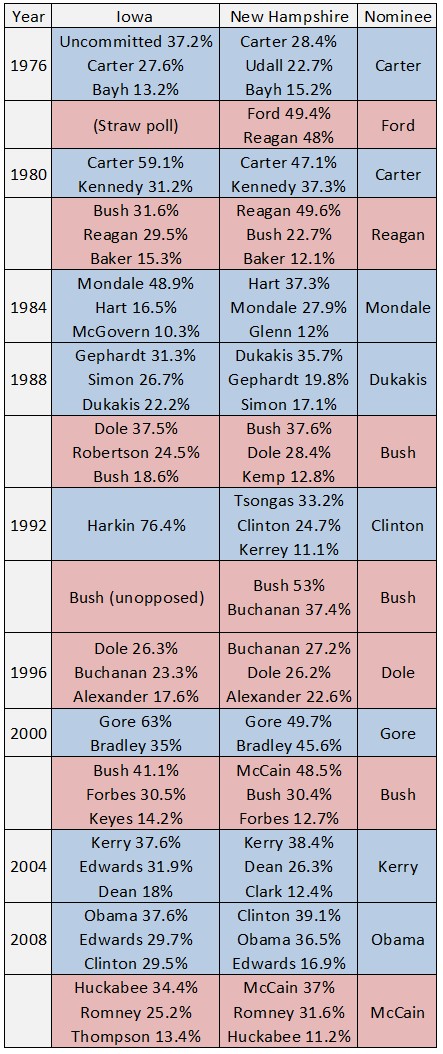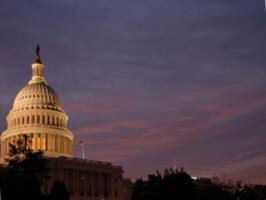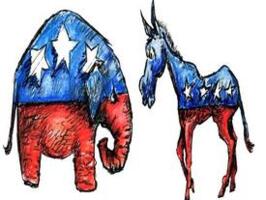Lessons from History: Don't Be Too Quick to Pull Down The Curtain
A Commentary By Larry J. Sabato
Over the decades, in every fourth year, we have noticed a tendency to close out the presidential nominating contest before the voting has even begun. There is a little of this impatience on display in 2011, too. It is only natural since the campaigns are nearly eternal. "Enough already!" many seem to be shouting.
Here at the Crystal Ball, we love history almost as much as current politics. The lesson of history is clear, as our quick-take chart shows: From 1976 to 2008, there has been a major surprise every time either in Iowa or New Hampshire. A back-of-the-pack candidate greatly exceeds expectations. Or the frontrunner stumbles. Or the field is scrambled in some other way.
First, take a look at Chart 1, which highlight the top finishers in the competitive Iowa caucuses and New Hampshire primaries dating back to 1976.
Chart 1: Iowa/New Hampshire results in competitive presidential nominating contests, 1976-2008
Notice any surprises? Think back:
- At this time in 1975, who thought Jimmy Carter would win Iowa and New Hampshire? Also, few correctly projected the '76 New Hampshire race between President Ford and Ronald Reagan. (Ford's 49.4% to 48% victory was close, similar to the final GOP National Convention balance between the two.)
- In fall 1979 there were few takers on a bet that George H.W. Bush would defeat Ronald Reagan in Iowa -- but he did.
- Walter Mondale's backers in 1983 were so concerned about Ohio's Senator-Astronaut John Glenn that they barely gave a thought to Gary Hart, much less the reality that Glenn would fade fast and Hart would whip the former vice president in New Hampshire.
- In 1987 few saw Vice President Bush -- Iowa's 1980 winner -- falling to third place in the Hawkeye State, with the Rev. Pat Robertson, of all people, as one of his tormentors. (Bob Dole was the other, in first place.)
- When Bill Clinton entered the Democratic presidential contest in October 1991, no other big names followed, and it was simply assumed he'd win New Hampshire. Paul Tsongas grabbed the victory instead, though Clinton (already engulfed by several of the scandals that would define the 1990s) managed to do well enough to call himself "the comeback kid."
- The real trouble in 1991 was brewing on the Republican side. The commentariat laughed when fiery Pat Buchanan decided to challenge the incumbent president for renomination. Pundit jaws hit the floor when Buchanan held the supposedly invincible Bush to a modest 53% to 37% margin.
- Buchanan became the second comeback kid four years later. Again, almost no one foresaw his defeating Bob Dole in New Hampshire in 1996.
- At this time in 1999, George W. Bush was soaring in the polls. Most analysts agreed: There was no way John McCain could beat him in New Hampshire. And then McCain won by 18 points.
- By the autumn of 2003, the collapse of John Kerry's campaign was apparent to all, and we "knew" the winner of the nomination would be John Edwards or Howard Dean. Kerry rose from the dead to take Iowa, almost in the final week of that contest, and never looked back until he was the Democratic nominee.
- John McCain played Lazarus again in 2008. Like Kerry four years earlier, his campaign displayed rigor mortis by fall 2007 as others (such as Rudy Giuliani, Fred Thompson, and Mitt Romney) vied to be the GOP standard-bearer. McCain revived early in the new year, then won quick decisive victories in New Hampshire, South Carolina and Florida. Frontrunner Rudy spent millions for one delegate.
- It's the Democratic contest of 2008 that should make us especially cautious about 2012. Hillary Clinton led Barack Obama by polling averages ranging up to 26% during 2007. And then Obama won Iowa on Jan. 3, 2008, and we all knew it was over. Except Clinton came right back, confounded most of the pollsters and took the crown back in New Hampshire. Back and forth it went between Obama and Clinton all the way to June.
OK, sure, you say. That's all in our past. We've got a much better fix on 2012. We've learned from our mistakes. We've got daily -- sometimes, hourly -- polls to keep us on the beam.
And your cloudy Crystal Ball counters with one question: Given the unimpressive record of early nomination predictions from 1976 to 2008, why should we think it will be any different this time?
Larry J. Sabato is the director of the Center for Politics at the University of Virginia.
See Other Commentary by Larry Sabato
See Other Political Commentary
Views expressed in this column are those of the author, not those of Rasmussen Reports. Comments about this content should be directed to the author.
Rasmussen Reports is a media company specializing in the collection, publication and distribution of public opinion information.
We conduct public opinion polls on a variety of topics to inform our audience on events in the news and other topics of interest. To ensure editorial control and independence, we pay for the polls ourselves and generate revenue through the sale of subscriptions, sponsorships, and advertising. Nightly polling on politics, business and lifestyle topics provides the content to update the Rasmussen Reports web site many times each day. If it's in the news, it's in our polls. Additionally, the data drives a daily update newsletter and various media outlets across the country.
Some information, including the Rasmussen Reports daily Presidential Tracking Poll and commentaries are available for free to the general public. Subscriptions are available for $4.95 a month or 34.95 a year that provide subscribers with exclusive access to more than 20 stories per week on upcoming elections, consumer confidence, and issues that affect us all. For those who are really into the numbers, Platinum Members can review demographic crosstabs and a full history of our data.
To learn more about our methodology, click here.



